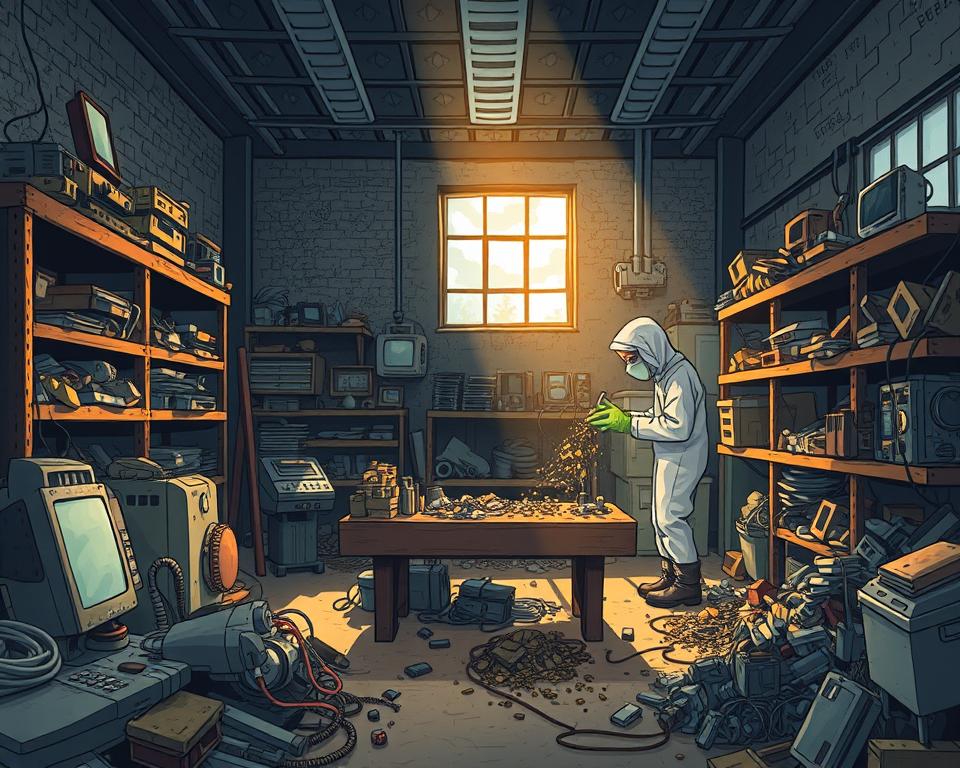Sustainable Strategies for Precious Metal Recovery
More than $60 billion in precious metals end up in e-waste every year—did you realize that? Such a massive amount highlights why precious metal recycling is so vital. It’s not just good for our economy but also for the environment. When we recover gold, silver, platinum, and palladium, we reduce pollution and conserve resources.
Firms like Dongsheng Metal Trading spearhead the movement toward greener recycling. They guarantee that valuable metals return to use instead of filling dumps. Such a precious metal recycling model drives eco-friendly recycling and sustainable methods.
Important Lessons
- Over $60 billion in precious metals is disposed of in electronic waste annually.
- Recycling precious metals shrinks environmental harm and saves resources.
- Gold, silver, platinum, and palladium top the list of valuable metals.
- Sustainable development depends on eco-friendly recycling.
- Firms such as Dongsheng Metal Trading focus on precious metal recovery.
Understanding Precious Metals and Their Value
Rare metallic elements known as precious metals attract both investors and manufacturers. Examples include gold, silver, platinum, and palladium, each prized for special traits. Notable traits are excellent conductivity, corrosion resistance, and rarity. The extraction and processing of these metals require considerable resources, underscoring the importance of recycling precious metals.

The value of precious metals is influenced by market demand and the inherent qualities of each metal. Metal recycling ensures the supply chain remains robust. It also reduces environmental impacts associated with mining activities. Through exhaustive recycling processes, these metals can be restored to their original state. This preserves finite resources while yielding economic benefits.
Defining Precious Metals
These metals’ special traits lend themselves to diverse applications. Scarcity plus special properties drive their economic importance. Notable examples are:
- Gold: Admired for its luster and low corrosion.
- Silver: Celebrated for its adaptability and conductivity.
- Pt: Esteemed for its toughness and catalyst role.
- Pd: Gaining traction in cars and electronics.
Why Recycle Precious Metals?
Recovering precious metals plays a crucial role in sustainability. It preserves resources and lessens the environmental cost of mining. Here are some benefits:
- Lessening of habitat destruction from mining.
- Energy needs are far lower than mining virgin ore.
- Contribution to a circular economy by reintroducing materials into production cycles.
- Economic upside from extracting high-value resources.
Why Precious Metal Recycling Matters
Metal recycling brings both green and economic gains. Highlighting these advantages is key to reducing our ecological footprint. Additionally, it fuels market growth and resilience.
Green Benefits
Green gains from metal recycling are huge. Retrieving metals from scrap and electronics reduces landfill load. This reduces the need for new mining, conserving natural resources.
This approach minimizes the harmful effects of mining, such as habitat destruction and pollution. Focusing on recycling precious metals helps us strive for a more sustainable future.
Economic Advantages
The economic benefits of recycling are equally compelling. Recovering metals cuts production expenses. This allows industries to use reclaimed metals instead of new ones.
This shift creates jobs in recycling facilities and boosts market stability as demand for recycled metals grows. Using these financial benefits, companies can improve profits. They also contribute to a greener economy.
The Precious Metal Recycling Process
Recovering precious metals involves multiple steps for peak efficiency. It starts with collecting metals from various sources like discarded electronics, jewelry, and industrial scraps. These materials then undergo sorting, cleaning, and analysis to determine their composition and value.
Recovery Steps
This systematic approach is vital for effective metal recovery. All stages focus on boosting metal yield. Sorting separates metals by type and purity. Decontamination eliminates residues that block recovery. Testing measures metal content to select proper recycling methods.
Metal Separation Techniques
High-tech methods are used to maximize metal retrieval. Thermal reduction, using high temperatures to separate metals from ores, is a key method. Melting refines and aggregates metals, while wet chemical processes are used for delicate separations. Firms such as Dongsheng Metal Trading apply these techniques to raise recovery and profits.
Recyclable Precious Metals
Recovery efforts support both ecology and resource reclamation. Many precious metals can be recycled, benefiting both the economy and the planet. It’s important for people and businesses to know which metals can be recycled.
Recycling Gold, Silver & Platinum
Gold, silver, and platinum stand out among precious metals. You’ll see them in rings, currency, and industrial parts. Recycling gold is common due to its high value and demand. Silver recovery matters too, thanks to its role in imaging, tech, and solar.
Platinum, though less common, is valuable, mainly in catalytic converters.
Electronics Precious Metals
Electronic precious metals offer unique recycling chances. Gadgets—from phones to laptops—house palladium, indium, and more. These metals are a treasure trove for recycling, reducing e-waste and providing essential materials.
Recycling these electronics metals is imperative. Sectors strive to cut waste and boost recycling efficiency.
Industry Benefits of Precious Metal Recovery
Recycling precious metals supports industries by providing efficient, green resource supply. Electronics, which embeds metals in gadgets, gains the most. Aerospace and healthcare rely on them for vital parts. Exploring how these industries recycle precious metals reveals the environmental and economic benefits.
E-Waste Sector
Electronics spearheads recovery, given the metal content in phones and PCs. Fast tech progress fuels growing e-waste volumes. Thus, recycling gold, silver, and palladium efficiently becomes vital. It preserves nature and lowers mining-driven CO₂ emissions.
Companies are increasingly focusing on recycling to meet global sustainability and waste reduction goals. This shift supports the ongoing need for resource conservation and environmental protection.
High-Tech Industries
Aerospace metal recycling is vital for the aerospace and medical industries, which rely on precious metals for critical components. Alloys prized for strength and anti-corrosion make up flight and medical components. Recycling these metals can significantly lower material costs and comply with environmental regulations.
They recognize that recycling offsets material scarcity. It also enhances operational efficiency, making recycling a key strategy for sustainability.
How to Choose a Metal Recycler
Choosing reputable metal recyclers is vital for success. Be sure to quiz them on their methods. Pricing models and processes make a big difference. Service comparisons help you pick the best recycler.
Questions to Ask Recycling Companies
- Which recovery certifications does your company have?
- Can you explain your processing methods for different metals?
- What yields can you deliver for gold, silver, and more?
- Can you detail your fees and any surcharges?
- Do you have client testimonials or references?
Evaluating Offers
You must evaluate services side-by-side to pick the right recycler. Create a table to compare key factors such as:
| Company Name | Recovery Rate (%) | Processing Fee ($) | Turnaround Time (Days) |
|---|---|---|---|
| Recycling Co. A | 95 | 50 | 7 |
| Recycling Co. B | 90 | 45 | 5 |
| Recycling Co. C | 92 | 55 | 10 |
Side-by-side comparisons help pinpoint the ideal recycler. This ensures you get the most value and meet industry standards.
Your Metal Recycling Handbook
Understanding how recyclers operate is key for those interested in precious metal recycling. These experts manage the entire process, from collection to processing. This ensures maximum efficiency and value from metals.
How Recyclers Operate
They apply high-tech processes—testing, sorting, refining—to recover metals. Collection comes from devices, jewelry, and industrial waste. Next, they employ precise methods to sort metals. In the last stage, precious metals are refined to purity.
It optimizes yield while advancing environmental goals. It’s fundamental to building a sustainable future.
Selecting Your Ideal Recycler
Key criteria matter when choosing a recycler. Begin by checking their green credentials. Now more than ever, green commitment is crucial. Also, consider the services they offer, from basic collection to full processing.
Pricing is another key factor. Get quotes to compare different options. Experts like Dongsheng Metal Trading provide industry-specific offerings. They are a reliable choice for specific recycling needs.
The Role of Metal Recycling Facilities
Recovery facilities are central to green waste solutions. There are specialized centers for different metals and materials. Understanding these facilities improves access to recyclers and their services. That supports firms and ecosystems alike.
Facility Categories
Metal recycling facilities vary widely in their operations. Some focus on precious metals, while others handle a wide range of materials. Here are a few common types:
- General scrap yards handle both ferrous and non-ferrous materials.
- High-value metal recyclers provide precision recovery for gold, silver, platinum, etc.
- E-waste hubs target valuable metals inside tech devices.
Location and Access to Facilities
Accessibility to recyclers is key for efficient metal recovery. Businesses must consider the logistics of transporting materials. Key access factors include:
| Factor | Description |
|---|---|
| Proximity | Closer sites cut shipping costs and delays. |
| Partnerships | Connections with nearby facilities speed up recycling. |
| Services Offered | Understanding the specific services of metal recycling facilities helps businesses select appropriate partners. |
Ultimately, facility type and access shape recycling success.
Recovering Metals from E-Waste
E-waste poses a major ecological challenge. Many e-waste items hold recoverable precious metals. That underscores viewing e-waste as a metal source.
Electronic Precious Metals
Gadgets harbor small quantities of precious metals. These metals are found in various parts:
- Circuit boards
- Connectors and ports
- Capacitors and resistors
- Battery terminals
Common electronics conceal recoverable metals. By recycling, we retrieve and reuse these valuable elements.
Why Recycle E-Waste?
Recycling electronics protects nature and recovers resources. That cuts landfill volume and conserves resources. The benefits of recycling e-waste metals are clear:
- It lowers pollution risks tied to discarded electronics
- It reduces CO₂ output via green recycling methods
- It fuels a circular economy by feeding materials back into manufacturing
Championing electronics recycling fosters responsible resource use. It lays the groundwork for a greener future.
Future Trends in Metal Recovery
Metal recycling is evolving, spurred by tech advances and green initiatives. Facing resource limits, recyclers embrace new methods. Adopting fresh techniques, they’re shaping tomorrow’s recycling.
Eco-Friendly Recycling Innovations
Modern green recycling strives to cut waste and eco-damage. Businesses adopt green packaging and energy-saving techniques. Such moves match worldwide green goals and nudge industries to be more eco-responsible.
Innovations in Precious Metal Recovery
Advances in recovery techniques are key to improving precious metal recycling efficiency. Automated sorters and hydrometallurgy ramp up yield. They boost recovery and cut environmental costs—a leap for metal recycling.
Starting a Precious Metal Recycling Venture
Launching a metal recovery firm requires careful strategy and market insight. Leaders should map out steps, secure compliance, and set firm roots. Key tasks include market studies and pinpointing customer segments. Securing licenses and legal compliance is crucial for long-term viability.
Business Setup Steps
To launch your recycling venture, follow these steps:
- Conduct market research to understand needs and rivals.
- Create a comprehensive plan with objectives and tactics.
- Acquire suitable recycling equipment that meets your operational needs.
- Secure funding through loans or investments.
- Obtain vital permits and licenses for legal operation.
- Implement a marketing strategy to draw in customers.
Compliance and Certifications
Grasping legal frameworks is essential for your recycling venture. Adherence to environmental regulations ensures your operation is safe and sustainable. Key considerations include:
- Securing business certification from relevant authorities.
- Ensuring full compliance with disposal and recycling laws.
- Training staff in safety protocols and best practices.
Final Thoughts
Recovering precious metals conserves resources and protects our planet. It allows individuals and businesses to lessen waste’s impact on our planet. The recovered metals reduce mining needs and boost the economy by creating jobs in recycling.
Beyond green gains, recycling yields financial perks. Working with Dongsheng Metal Trading guarantees green standards. That partnership bolsters circular models for recyclers and buyers alike.
A sustainable tomorrow hinges on our joint metal-recycling efforts. Increased awareness builds a culture of green consumption and care. Adopting these practices will benefit us now and secure a greener future for generations to come.


